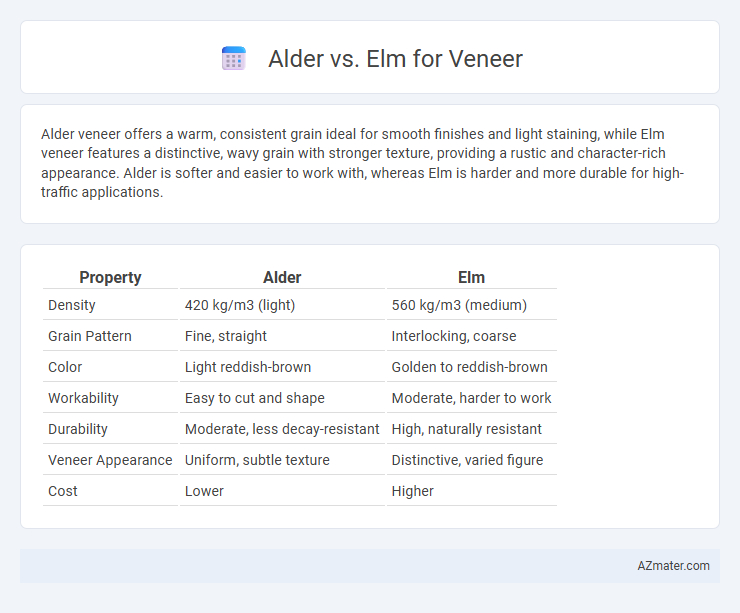Alder veneer offers a warm, consistent grain ideal for smooth finishes and light staining, while Elm veneer features a distinctive, wavy grain with stronger texture, providing a rustic and character-rich appearance. Alder is softer and easier to work with, whereas Elm is harder and more durable for high-traffic applications.
Table of Comparison
| Property | Alder | Elm |
|---|---|---|
| Density | 420 kg/m3 (light) | 560 kg/m3 (medium) |
| Grain Pattern | Fine, straight | Interlocking, coarse |
| Color | Light reddish-brown | Golden to reddish-brown |
| Workability | Easy to cut and shape | Moderate, harder to work |
| Durability | Moderate, less decay-resistant | High, naturally resistant |
| Veneer Appearance | Uniform, subtle texture | Distinctive, varied figure |
| Cost | Lower | Higher |
Introduction to Alder and Elm Veneer
Alder veneer offers a smooth, lightweight wood surface with a warm, reddish-brown hue, making it popular for furniture and cabinetry that require a natural, understated look. Elm veneer features a distinctive interlocking grain pattern and rich, golden tones, prized for its durability and visually striking appearance in decorative woodwork. Both veneers provide versatile, high-quality options, with alder emphasizing subtle elegance and elm showcasing bold, natural character.
Botanical Overview: Alder vs Elm
Alder (genus Alnus) and Elm (genus Ulmus) are deciduous hardwood trees commonly used for veneer due to their distinct grain patterns and durability. Alder wood is typically softer with a fine, uniform texture and tends to have a light brown color, while Elm features interlocking grain, which creates unique and attractive patterns, along with higher resistance to splitting. Botanically, Alder thrives in moist environments and is part of the birch family (Betulaceae), whereas Elm grows in varied habitats, belonging to the Ulmaceae family, known for its toughness and elasticity.
Grain Patterns and Aesthetic Differences
Alder veneer features a subtle, straight grain with occasional knots, offering a warm, uniform appearance ideal for rustic or traditional settings. Elm veneer showcases a more pronounced, interlocking grain with distinctive cathedral patterns and irregular swirls, providing a dynamic and textured aesthetic suited for contemporary or eclectic designs. Both woods present unique visual characteristics, with alder emphasizing smoothness and consistency, while elm highlights complexity and natural artistry in grain patterns.
Color Variations in Alder and Elm Veneer
Alder veneer exhibits warm, reddish-brown hues with subtle grain patterns, creating a rich and inviting appearance that deepens over time. Elm veneer offers more distinctive color variations, ranging from light yellowish-browns to medium reddish tones, often highlighted by intricate grain patterns and occasional darker streaks. Both woods provide versatile options for veneer applications, with Alder favoring consistent warmth and Elm delivering dynamic, natural contrasts.
Workability and Machining
Alder wood offers excellent workability with smooth cutting, sanding, and finishing characteristics, making it highly suitable for veneer applications that require precise machining. Elm provides a denser grain and slightly higher resistance to machining, which can enhance durability but may require sharper tools and slower feed rates to avoid tear-out during veneer production. Both species yield attractive veneers, but Alder's ease of handling often results in more consistent, high-quality finishes for cabinetry and furniture surfaces.
Durability and Strength Comparison
Alder veneer offers moderate durability with a Janka hardness rating of approximately 590, making it softer and more prone to dents compared to Elm, which has a Janka hardness of around 830. Elm veneer is known for its superior strength, featuring interlocking grain patterns that enhance resistance to splitting and warping. For applications requiring more robust wear and structural integrity, Elm veneer provides a more durable and resilient option than Alder.
Common Applications in Veneer Projects
Alder veneer is prized for its smooth texture and warm, reddish-brown tones, making it ideal for furniture, cabinetry, and decorative paneling in residential and commercial interiors. Elm veneer features a distinctive interlocking grain pattern with rich golden hues, commonly used in upscale office furnishings, architectural millwork, and high-end veneer wall coverings. Both woods offer excellent machinability and finish adhesion, but alder is preferred for projects requiring consistent coloration while elm is selected for visual impact and unique grain character.
Cost and Availability Factors
Alder veneer offers a cost-effective option due to its wide availability in North America, making it more affordable for large-scale projects. Elm veneer, although less common, commands a higher price because of its limited supply and unique grain patterns prized for specialty woodworking. Project budgets and material accessibility largely influence the choice between alder and elm veneers.
Sustainability and Environmental Impact
Alder veneer offers moderate sustainability due to its fast growth and widespread availability, making it a renewable resource with lower environmental impact compared to hardwood alternatives. Elm veneer, although less common, provides significant durability and resistance, but its slower growth rate and limited supply can contribute to greater ecological strain. Choosing Alder supports more sustainable forestry practices, while Elm demands careful sourcing to minimize deforestation and habitat disruption.
Choosing the Right Veneer: Alder or Elm
Alder veneer offers a fine, uniform grain with a warm, reddish-brown hue, ideal for modern and rustic furniture designs requiring a smooth finish and easy staining. Elm veneer features a unique interlocking grain pattern with rich, golden-brown tones, providing durability and striking visual texture for traditional or artistic woodworking projects. Selecting between alder and elm veneers depends on desired aesthetics, grain complexity, and the specific application's durability needs.

Infographic: Alder vs Elm for Veneer
 azmater.com
azmater.com